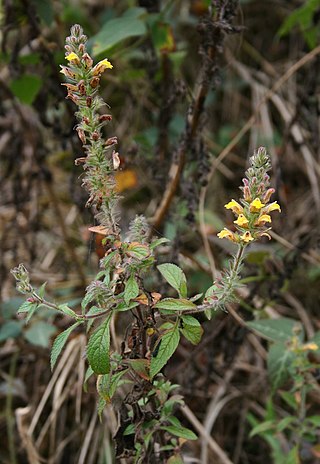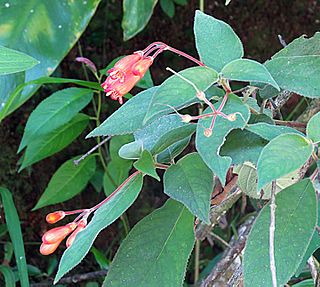
Martin H[e]inrich Carl Lichtenstein was a German physician, explorer, botanist and zoologist. He explored parts of southern Africa and collected natural history specimens extensively and many new species were described from his collections by European scientists.

Vismia is a genus of flowering plants in the family Hypericaceae. Members of the genus are small trees and shrubs found in tropical and subtropical areas of Central America and South America. Including the countries of Belize, Bolivia, Brazil, Colombia, Costa Rica, Ecuador, El Salvador, French Guiana, Guatemala, Guyana, Honduras, Mexico, Nicaragua, Panamá, Peru, Suriname, Trinidad-Tobago and Venezuela.

Agathosma is a genus of about 140 species of flowering plants in the family Rutaceae, native to the southern part of Africa. Common names include buchu, boegoe, bucco, bookoo and diosma. Buchu formally denotes two herbal species, prized for their fragrance and medicinal use despite their toxicity. In colloquial use however, the term is applied to a wider set of fragrant shrubs or substitutes.

Lindenbergia is a genus of herbaceous plants in the order Lamiales and in the broomrape family Orobanchaceae. It is one of the few genera of the family which are not parasitic. It contains about 15 species found from northeast Africa across Asia to the Philippines, and is most abundant in India.

Poupartia is a genus of plant in family Anacardiaceae. From the islands of Madagascar, Mauritius, Rodrigues and Réunion, all in the Indian Ocean.

Zygophyllum is the type genus of the flowering plant family Zygophyllaceae. The generic name is derived from the Greek words ζυγόν (zygon), meaning "double", and φυλλον (phyllon), meaning "leaf". It refers to the leaves, each of which have two leaflets.
Suchtelenia is a monotypic genus of flowering plant belonging to the family Boraginaceae. It only contains one known species, Suchtelenia calycina(C.A.Mey.) DC.
Escobedia is a genus of flowering plants belonging to the family Orobanchaceae.
Staelia is a genus of flowering plants belonging to the family Rubiaceae.
Sommera is a genus of flowering plants belonging to the family Rubiaceae.
Romanschulzia is a genus of flowering plants belonging to the family Brassicaceae.
Esterhazya is a genus of flowering plants belonging to the family Orobanchaceae.
Passovia is a genus of flowering plants belonging to the family Loranthaceae.

Gaudichaudia is a genus of flowering plants belonging to the family Malpighiaceae.

Moussonia is a genus of plants in the family Gesneriaceae. Its native range stretches from Mexico to Central America. It is found in Costa Rica, El Salvador, Guatemala, Honduras, Mexico and Panamá.








